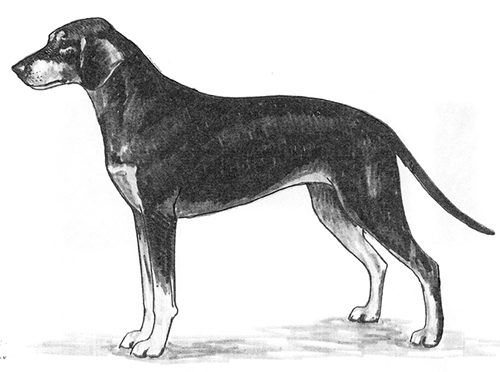Hellenic hound
Scenthound Group
The goals and purposes of this breed standard include: to furnish guidelines for breeders who wish to maintain the quality of their breed and to improve it; to advance this breed to a state of similarity throughout the world; and to act as a guide for judges.
Breeders and judges have the responsibility to avoid any conditions or exaggerations that are detrimental to the health, welfare, essence and soundness of this breed, and must take the responsibility to see that these are not perpetuated.
Any departure from the following should be considered a fault, and the seriousness with which the fault should be regarded should be in exact proportion to its degree and its effect upon the health and welfare of the dog and on the dog’s ability to perform its traditional work.
History
The Hellenic Hound is a medium sized scenthound that originated in Greece.
The Hellenic Hound was recognized by the United Kennel Club in 2006.
General Appearance
A medium sized, short coated, black and tan hound that appears strong and vigorous.
Characteristics
Lively and keen.
Head
The head is long, and has divergent planes of the top skull and muzzle.
Serious Fault: Parallel planes of the skull and muzzle.
SKULL
The width of the skull is not more than half the total length of the head. The forehead is quite broad, and the skull is fairly flat. The superciliary arches are high. The stop is not pronounced.
MUZZLE
The muzzle is as long as, or slightly longer than, the skull. The nasal bridge is straight or slightly arched in males. The lips are well developed, and the edges of the lips are black.
Serious Faults: Pointed muzzle. Concave nasal bridge.
TEETH
The Hellenic Hound has a complete set of evenly spaced, white teeth meeting in a scissors or level bite.
Disqualifications: Overshot or undershot bite.
NOSE
The black nose overhangs the forward vertical lip line.
EYES
The medium sized, brown eyes have a lively, intelligent expression. The eyerims are black.
EARS
The medium length ears are set on high. They are flat and slightly rounded at the tips.
Disqualification: Semi-erect ears.
Neck
Muscular and powerful, without dewlap.
Forequarters
The shoulder blades and upper arms are sloping and muscular.
FORELEGS
The legs are straight, long and well boned. The pastern joint is lean, and the pasterns are fairly long, strong and quite upright.
Body
The length of the body is 10 percent greater than the height at the withers. The chest is well developed and deep. The ribs are lightly sprung. The withers are slightly raised, and the topline is straight to the loin, which is slightly arched. The back is long and straight. The croup is long, broad and slightly sloping. The belly is lean and slightly tucked up.
Hindquarters
The hindquarters are well muscled and robust.
HIND LEGS
The thighs are long and strong. There is good angulation at the stifle and hock joints. The rear pasterns are lean and quite long.
Feet
The feet are rounded and compact, with arched toes and hard pads.
Tail
The tail is set rather high. It is thick at the root, and tapers to the end, which reaches just to the hock joint. The tail is carried in saber fashion.
Coat
Short, dense and close fitting.
Color
Black and tan. A small white spot on the chest is tolerated.
Disqualification: Any color other than black and tan.
Height and Weight
Height at the withers for males is 18.5 to 21.5 inches. For females, it is 17 to 20.5 inches.
Weight is approximately 37 to 44 pounds.
Gait
Swift and light.
Eliminating Faults
(An Eliminating Fault is a Fault serious enough that it eliminates the dog from obtaining any awards in a conformation event.)
Height more than one inch over or under the standard.
Disqualifications
(A dog with a Disqualification must not be considered for placement in a conformation event, and must be reported to UKC.)
Unilateral or bilateral cryptorchid.
Viciousness or extreme shyness.
Albinism.
Overshot or undershot bite.
Semi-erect ears.
Any color other than black and tan.

Looking for a Dog?
Find a dog that will fit your family.
Note: The breeders on this list are not endorsed by UKC.
Revised July 1, 2009
©Copyright 2006, United Kennel Club
